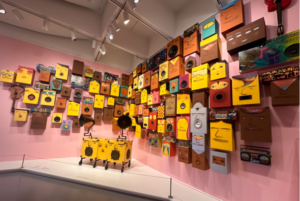Review of Manifesto: Art x Agency

Image courtesy of The Hirshhorn Museum and Sculpture Garden
By Jacqueline Jedrych
Many modernist, avant-garde art movements are founded with manifestos, binding politics and art together. Politics is art and art is politics, as shown in the poignant exhibit Manifesto: Art x Agency at the Hirshhorn Museum and Sculpture Garden. The exhibit opened June 15, 2019, and will run through January 5, 2020.
The exhibition features three sections. The first displays some of the 20th and 21st century’s most well-known modernist art pieces, including pieces by Salvador Dalí, George Grosz, René Magritte, Jackson Pollock, Tsuruko Yamazaki, and many other leaders in the modernist art movements. These pieces are displayed alongside some published manifestos featuring texts from futurism, surrealism, constructivism, and lyrical abstraction. The section informs the viewer of the expansive history of the modernist art movements. For the average person, modern art is an intimidating sphere to enter, due to its elitist nature and expanse of content. The history displayed in the first section is digestible enough for anyone to understand and is displayed with many pieces from the various movements, helping to put a style to the information presented.
As the viewer exits the historical section, they enter a dark room. The walls are covered by heavy, black curtains with 13 screens around the room. The first screen features a video of a fuse burning as an excerpt from The Communist Manifesto is read. As the scenes continue, they play clips from Manifesto, a feature-length film by German artist Julian Rosefeldt.
The film shows Cate Blanchette reading pieces from various art manifestos while participating in some sort of scene. For example, the scene around a recitation from the Dadaist Manifesto is of a widow at a funeral. Dadaism, founded in the wake of the Russian Revolution, represents the absurdity in life and rejects logic. This movement of art espouses the idea of creativity for nothing’s sake because everything is futile. The scenes are absolutely captivating and compelling, culminating simultaneously to shock the limits of visual perception. Altogether, this exhibit is a great taste of modernist art movements.
The final section displays highly political pieces from the permanent collection, dating from the 1960’s to present. The section includes contemporary artists such as The Guerilla Girls, Adrian Pipe, Alfredo Jaar, and June Paik. All of the pieces address important social justice issues. This space, with white walls, fluorescent lighting, and tiled floors, highly contrasts with the darkness of the previous room. It supplies an unobtrusive background in which to observe the pieces.
Manifesto: Art x Exhibition marries art and politics, while remaining digestible enough for the average viewer. The structure and flow are carefully planned to open the viewer’s mind to new connections between art and politics.





